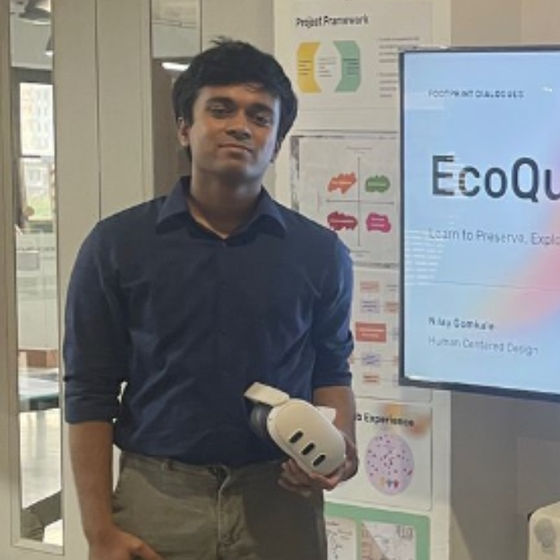UX Design for Virtual Reality
How This Course Will Transform Your Career
In This Course, You'll
Get excited when you learn how to create virtual reality (VR) experiences people love. The global VR market will grow to $227 billion by 2029! Whether you want to create VR games or interactive business solutions, this course will help you bring your big ideas to life. VR opens up a new dimension for your creativity, literally! Virtual reality lets people step into digital worlds for a deeper emotional connection. It leads to higher retention, engagement, and loyalty in gaming, education, and corporate training.
Make yourself invaluable with specialized knowledge and in-demand skills that open doors to exciting career paths! Does UX Design for Virtual Reality sound complicated? It can be, but we've made it easy for you! With step-by-step guidance, you'll master it faster than you think—no matter your background. The UX Design for VR course shows you how to create VR products that make a real impact in any industry. You'll explore social VR and the Metaverse and master the secret to achieving comfort, safety, and inclusivity in VR. You'll be able to design for presence and immersion with VR elements like storytelling, sound design, spatial audio, and emotion design.
Gain confidence and credibility as you conceptualize, create, and refine VR prototypes for your portfolio. You can choose to create a complete VR portfolio project, from storyboarding to 3D prototyping, and walk away with a polished portfolio that puts you in demand. Download ready-to-use templates, like the 3D wireframe checklist and USE scorecard for VR, to fast-track your success in one of the most sought-after areas of UX design.
It's Easy to Fast-Track Your Career with the World's Best Experts
Master complex skills effortlessly with proven best practices and toolkits directly from the world's top design experts. Meet your experts for this course:
Frank Spillers: Service Designer and Founder and CEO of Experience Dynamics.
Mel Slater: Distinguished Investigator at the University of Barcelona in the Department of Clinical Psychology, active member of the Institute of Neurosciences, and Co-Director of Event Lab (Experimental Virtual Environments for Neuroscience and Technology).
Gain an Industry-Recognized UX Course Certificate
Use your industry-recognized Course Certificate on your resume, CV, LinkedIn profile or your website.

Our courses and Course Certificates are trusted by these industry leaders:

Why Learn UX Design for Virtual Reality?
UX Design for Virtual Reality falls under the umbrella term of User Experience (UX) design. UX design is your fast-track to a meaningful, secure, and rewarding career.
Worried You'll Lose Your Job to AI? UX Design Skills Make You AI-Proof
UX design builds on your core human strengths such as emotional intelligence, deep human understanding, critical thinking, intuition, and imagination.
AI can't replicate your uniquely human ability to design for real emotions and needs such as joy, comfort, curiosity, safety, and a sense of belonging. These deeply human insights are your superpowers. With UX design skills, you'll turn them into products and experiences people truly love. You become irreplaceable, confident and in demand.
And yes, we'll also show you how to use AI to accelerate your results.
Feeling Stuck in the 9–5? Design Your Freedom
Tired of feeling undervalued, anxious, or trapped in your career? UX design skills open doors to freedom, flexibility, remote work, and a career you're excited about—without starting from scratch.
Stop wondering if you could be more. Start realizing your full potential today.
UX Design is Booming: Accelerate Your Career to Higher Salaries and Impact Across All Jobs and Industries
Salaries for people with design skills are soaring, often surpassing $200K in cities like San Francisco, and job growth is strong (13% globally). Why? Because companies thrive when their users are happy. Companies that invest in great design outperform the S&P 500 Index by a whopping 228%.
Design a Life You Love
Great design is all about helping people meet their needs and achieve their goals through intuitive, meaningful, and delightful experiences. Skills in design will empower you to create experiences and products that make people's lives easier and more fulfilling. And when people love what you create, your business thrives, and your salary potential grows. You get the ultimate double win:
You'll feel deeply fulfilled by designing experiences and products people love.
You'll be financially rewarded for your real-world impact.
Course Overview: What You'll Master
- Each week, one lesson becomes available.
- There's no time limit to finish a course. Lessons have no deadlines.
- Estimated learning time: 14 hours 41 mins spread over 4 weeks.
Lesson 0: Welcome and Introduction
To be scheduled. Estimated time to complete: 1 hour 44 mins.
-
0.1: An Introduction to Courses from IxDF (37 mins)
-
0.2: Get Help, Career Advice, and Job Opportunities (6 mins)
-
0.3: How to Get Your Course Certificate (19 mins)
-
0.4: Grow Your Global Network and Build Your Brand (12 mins)
-
0.5: Global Skills, Local Jobs: Build Your Network in Your Area (2 mins)
-
0.6: Get Timeless Skills with Courses from IxDF (21 mins)
-
0.7: Mandatory vs Optional Lesson Items (7 mins)
-
0.8: Learn Smarter: The Perfect Mix of Video and Text (5 mins)
Lesson 1: Journey into UX for VR
To be scheduled. Estimated time to complete: 3 hours 11 mins.
-
1.1: Welcome to UX Design for Virtual Reality (14 mins)
-
1.2: The Past, Present and Future of Virtual Reality (25 mins)
-
1.3: UX Design Fundamentals in the World of VR (17 mins)
-
1.4: The Journey of the UX Design Process in VR (38 mins)
-
1.5: How to Design for VR: From 2D to 3D (21 mins)
-
1.6: The VR Environment: What Are its Limits and Opportunities? (57 mins)
-
1.7: Conversations: Apply Traditional UX Design Principles to VR (7 mins)
-
1.8: Build Your Portfolio: Define Your VR Project’s Objectives (9 mins)
-
1.9: Congratulations and Recap (6 mins)
Lesson 2: VR User Research Essentials: From Analysis to Action
To be scheduled. Estimated time to complete: 2 hours 26 mins.
-
2.1: Welcome and Introduction (2 mins)
-
2.2: How to Understand User Needs in Virtual Reality (30 mins)
-
2.3: How to Understand Your VR Users: Techniques for Insights (1 hour 12 mins)
-
2.4: How to Design for All: Inclusivity in Virtual Reality (22 mins)
-
2.5: Conversations: Analyze and Apply Research Findings to VR projects (7 mins)
-
2.6: Build Your Portfolio: Conduct Your Own User Interviews (10 mins)
-
2.7: Congratulations and Recap (6 mins)
Lesson 3: How to Design for Immersion and Presence in VR
To be scheduled. Estimated time to complete: 3 hours 41 mins.
-
3.1: Welcome and Introduction (9 mins)
-
3.2: How to Design Virtual Worlds: Strategies for Immersion and Presence (21 mins)
-
3.3: How to Use Narrative as a Design Tool (37 mins)
-
3.4: Three Skills for 3D: Storytelling, Improv and Imagineering (53 mins)
-
3.5: Enter the World of Social VR (20 mins)
-
3.6: Beyond Sight and Sound: Emotion-Driven Immersive Design (57 mins)
-
3.7: Conversations: Design for the Metaverse (13 mins)
-
3.8: Build Your Portfolio: Create a Storyboard (9 mins)
-
3.9: Congratulations and Recap (6 mins)
Lesson 4: How to Design Interactions and Interfaces for Immersive VR
To be scheduled. Estimated time to complete: 2 hours 23 mins.
-
4.1: Welcome and Introduction (2 mins)
-
4.2: How to Navigate Virtual Worlds: VR Interface Design (46 mins)
-
4.3: VR Interaction Design: How to Build Virtual Worlds Through User Engagement (18 mins)
-
4.4: Inside Virtual Worlds: Key VR Interaction Concepts (14 mins)
-
4.5: How to Develop an Interaction Model in VR (25 mins)
-
4.6: How to Ensure User Comfort and Safety in Virtual Reality (23 mins)
-
4.7: Conversations: Text in the Virtual World—Design Challenges and Opportunities (6 mins)
-
4.8: Build Your Portfolio: Develop Your VR Interaction Model (8 mins)
-
4.9: Congratulations and Recap (6 mins)
Lesson 5: From Idea to Interaction: VR Prototyping and Testing
To be scheduled. Estimated time to complete: 3 hours 0 mins.
-
5.1: Welcome and Introduction (2 mins)
-
5.2: Prototyping for VR: From Concept to Creation (40 mins)
-
5.3: How to Optimize VR: Best Practices for Designers (13 mins)
-
5.4: How to Implement VR Experiences (20 mins)
-
5.5: How to Evaluate Your VR Designs (38 mins)
-
5.6: Heuristics in VR: A Designer's Guide (44 mins)
-
5.7: Conversations: Explore the Potential of Illusions in Virtual Reality (7 mins)
-
5.8: Build Your Portfolio: 3D Prototyping (9 mins)
-
5.9: Congratulations and Recap (12 mins)
Lesson 6: IxDF Course Certificate and Course Wrap-up
To be scheduled. Estimated time to complete: 12 mins.
-
0.1: How to Add Your IxDF Certificate to LinkedIn (6 mins)
-
0.2: Help Us Help You: Course Evaluation (4 mins)
-
0.3: Six Steps to Your Career Success (3 mins)
-
0.4: Get Your IxDF Course Certificate (2 mins)
How Others Have Benefited

Dean Lodes, United States
“The course was well-designed and taught. The knowledge base is very high and well-shared.”

Nilay Gomkale, India
“The instructor showed clear experience and insight that they shared through the course, conveyed along with excellent examples.”

Dr Marco Gilardi, United Kingdom
“The course covers a great deal of material in an accessible way, providing a good overview on UX for VR”
How It Works
-
Take online courses by industry experts
Lessons are self-paced so you'll never be late for class or miss a deadline.
-
Get a Course Certificate
Your answers are graded by experts, not machines. Get an industry-recognized Course Certificate to prove your skills.
-
Advance your career
Use your new skills in your existing job or to get a new job in UX design. Get help from our community.
Start Advancing Your Career Now
Join us to take “UX Design for Virtual Reality”. Take other courses at no additional cost. Make a concrete step forward in your career path today.
Advance my career now